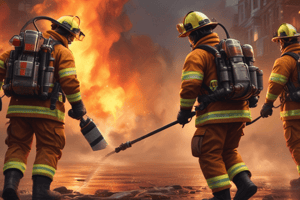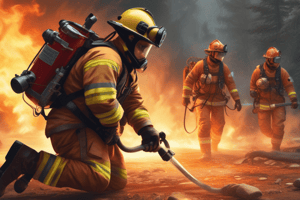Podcast
Questions and Answers
What is one of the key responsibilities of an individual firefighter in Mayday prevention?
What is one of the key responsibilities of an individual firefighter in Mayday prevention?
- Conducting public education programs
- Directing incident response operations
- Maintaining SCBA proficiency (correct)
- Supervising other firefighters
Which responsibility pertains specifically to the Company Officer in the context of Mayday readiness?
Which responsibility pertains specifically to the Company Officer in the context of Mayday readiness?
- Ensure all firefighters use personal protective equipment correctly
- Integrate a daily SCBA check into the crew routine (correct)
- Lead first aid training for all crew members
- Establish engagement with the community for fire safety
In the event of a Mayday situation, the initial response should be managed at which level?
In the event of a Mayday situation, the initial response should be managed at which level?
- State-level emergency services
- Individual firefighter level
- Company level (correct)
- National response coordination
Which aspect of crew communication is emphasized for the Company Officer during Mayday prevention?
Which aspect of crew communication is emphasized for the Company Officer during Mayday prevention?
What should individual firefighters do if they notice a lack of integration of a roving firefighter into the crew?
What should individual firefighters do if they notice a lack of integration of a roving firefighter into the crew?
Which of the following is NOT mentioned as a responsibility for an individual firefighter in Mayday prevention?
Which of the following is NOT mentioned as a responsibility for an individual firefighter in Mayday prevention?
What is a crucial aspect of a firefighter's response during a Mayday situation to increase the chances of survival?
What is a crucial aspect of a firefighter's response during a Mayday situation to increase the chances of survival?
Which practice is NOT advised for the Company Officer concerning Mayday readiness?
Which practice is NOT advised for the Company Officer concerning Mayday readiness?
Working within an Incident Command System is crucial for effective incident management.
Working within an Incident Command System is crucial for effective incident management.
Freelancing is encouraged within the incident command system to promote individual initiative.
Freelancing is encouraged within the incident command system to promote individual initiative.
Maintaining individual air management is unnecessary during emergency incidents.
Maintaining individual air management is unnecessary during emergency incidents.
Planning an exit strategy is part of managing risks in an incident.
Planning an exit strategy is part of managing risks in an incident.
Layering of resources is not important in emergency response planning.
Layering of resources is not important in emergency response planning.
Working within an Incident Command System is essential for effective incident management.
Working within an Incident Command System is essential for effective incident management.
Freelancing is a common practice within the Incident Command System to allow for individual decision-making.
Freelancing is a common practice within the Incident Command System to allow for individual decision-making.
Maintaining individual and crew air management is crucial during emergency incidents.
Maintaining individual and crew air management is crucial during emergency incidents.
Layering of resources is not considered important in emergency response planning.
Layering of resources is not considered important in emergency response planning.
Planning and acting out an exit plan is part of managing risks in an incident.
Planning and acting out an exit plan is part of managing risks in an incident.
Match the following responsibilities with their descriptions:
Match the following responsibilities with their descriptions:
Match the following concepts with their meanings:
Match the following concepts with their meanings:
Match the following actions with their purposes:
Match the following actions with their purposes:
Match the following best practices with their objectives:
Match the following best practices with their objectives:
Match the key components of incident management with their importance:
Match the key components of incident management with their importance:
Flashcards are hidden until you start studying
Study Notes
Mayday Readiness and Response Responsibilities
- Firefighters must actively prepare for and respond to Mayday situations.
- Individual responsibilities focus on Mayday prevention through consistent training and skill maintenance.
Individual Firefighter Responsibilities for Mayday Prevention
- Maintain proficiency in Self-Contained Breathing Apparatus (SCBA).
- Practice individual air management techniques.
- Properly use and care for personal protective equipment (PPE).
- Ensure proficiency in portable radio operations.
- Engage in practiced crew communications.
- Integrate roving/replacement firefighters into the crew dynamics, where individuals should communicate needs if not initiated by the Company Officer.
Company Officer Responsibilities for Mayday Prevention
- Develop and practice crew readiness to ensure rapid responses.
- Foster a culture of Mayday prevention and improve expectations among crew members.
- Incorporate daily SCBA checks as routine practice.
- Practice effective crew communication, especially within hazard zones.
- Be proactive about integrating rovers and ensure discussions about roles at the start of shifts.
- Maintain awareness of portable radios and cultivate their effective use.
- Clarify Company Officer expectations and responsibilities to all crew members.
- Emphasize crew integrity and accountability.
- Instill the practice of staying connected to the hoseline during emergencies.
Individual Firefighter Response to Mayday Situations
- Focus on enhancing the survival chances in a Mayday scenario.
- Skills development begins at the recruit level and requires ongoing application throughout a firefighter's career.
- Initially manage the Mayday response at the company level, triggering a defined help order upon recognition.
Key Responsibilities for Mayday Response
- Maintain readiness and proactive reaction skills.
- Communicate the Mayday situation early and effectively.
- Control emotional responses during emergencies.
- Use the B.O.A. principle:
- Breath
- Organize
- Act
- Engage in IAFF Fire Ground Survival training which encompasses:
- SCBA familiarization
- High/low profile wall breach techniques
- Disentanglement skills
- Ladder bail execution
- Window hang strategies
- GRABLIVES technique:
- G: Check air gauge
- R: Radio for assistance
- A: Activate PASS device
- B: Control breathing and conserve air
- L: Stay low
- I: Illuminate surroundings with a flashlight
- V: Make loud noises for attention
- E: Find an exit route
- S: Shield your airway as a last-ditch effort.
Incident Command System/Risk Management System
- Operates under a structured framework to effectively manage incidents and risks.
- Ensures clear roles and responsibilities are established for all personnel involved.
Incident Action Plan
- A strategic plan outlining objectives and actions to be taken during an incident.
- Guides operational tactics and resource deployment to achieve incident goals.
Accountability in Incident Command
- Always report to a designated authority within the incident command system to ensure coordinated efforts.
- Freelancing or acting independently can lead to safety risks and operational confusion.
Air Management
- Prioritizes maintaining individual and crew air supply during operations to prevent emergencies.
- Involves regular monitoring of air levels and potentially altering tasks based on air availability.
Work Cycle Management
- Organizes and manages the durations of active work and rest periods for personnel.
- Aims to enhance efficiency and reduce fatigue among responders.
Monitoring Distances Traveled
- Tracks how far personnel travel into buildings to assess risk and ensure safety.
- Provides critical data for planning exits and resource allocation during an incident.
Resource Layering and Tactical Reserves
- Involves deploying resources in a tiered manner to maintain operational flexibility.
- Establishes tactical reserves to support ongoing operations and respond to unexpected developments.
Exit Plan Planning and Execution
- Develops a clear exit strategy ahead of time for all personnel involved in operations.
- Ensures all team members are aware of exit routes and procedures to enhance safety and efficiency during transitions.
Incident Command System/Risk Management System
- Operates under a structured framework to effectively manage incidents and risks.
- Ensures clear roles and responsibilities are established for all personnel involved.
Incident Action Plan
- A strategic plan outlining objectives and actions to be taken during an incident.
- Guides operational tactics and resource deployment to achieve incident goals.
Accountability in Incident Command
- Always report to a designated authority within the incident command system to ensure coordinated efforts.
- Freelancing or acting independently can lead to safety risks and operational confusion.
Air Management
- Prioritizes maintaining individual and crew air supply during operations to prevent emergencies.
- Involves regular monitoring of air levels and potentially altering tasks based on air availability.
Work Cycle Management
- Organizes and manages the durations of active work and rest periods for personnel.
- Aims to enhance efficiency and reduce fatigue among responders.
Monitoring Distances Traveled
- Tracks how far personnel travel into buildings to assess risk and ensure safety.
- Provides critical data for planning exits and resource allocation during an incident.
Resource Layering and Tactical Reserves
- Involves deploying resources in a tiered manner to maintain operational flexibility.
- Establishes tactical reserves to support ongoing operations and respond to unexpected developments.
Exit Plan Planning and Execution
- Develops a clear exit strategy ahead of time for all personnel involved in operations.
- Ensures all team members are aware of exit routes and procedures to enhance safety and efficiency during transitions.
Incident Command System/Risk Management System
- Operates under a structured framework to effectively manage incidents and risks.
- Ensures clear roles and responsibilities are established for all personnel involved.
Incident Action Plan
- A strategic plan outlining objectives and actions to be taken during an incident.
- Guides operational tactics and resource deployment to achieve incident goals.
Accountability in Incident Command
- Always report to a designated authority within the incident command system to ensure coordinated efforts.
- Freelancing or acting independently can lead to safety risks and operational confusion.
Air Management
- Prioritizes maintaining individual and crew air supply during operations to prevent emergencies.
- Involves regular monitoring of air levels and potentially altering tasks based on air availability.
Work Cycle Management
- Organizes and manages the durations of active work and rest periods for personnel.
- Aims to enhance efficiency and reduce fatigue among responders.
Monitoring Distances Traveled
- Tracks how far personnel travel into buildings to assess risk and ensure safety.
- Provides critical data for planning exits and resource allocation during an incident.
Resource Layering and Tactical Reserves
- Involves deploying resources in a tiered manner to maintain operational flexibility.
- Establishes tactical reserves to support ongoing operations and respond to unexpected developments.
Exit Plan Planning and Execution
- Develops a clear exit strategy ahead of time for all personnel involved in operations.
- Ensures all team members are aware of exit routes and procedures to enhance safety and efficiency during transitions.
Studying That Suits You
Use AI to generate personalized quizzes and flashcards to suit your learning preferences.




